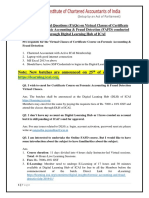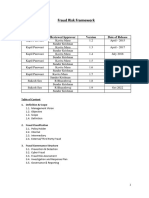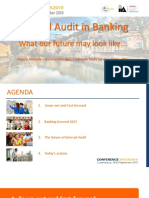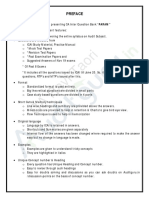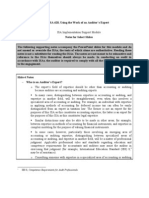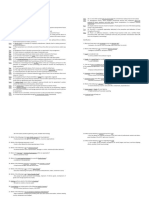ACFE SAMPLE QUESTIONS
1.To understate net income and lower income tax liability, an accountant could fraudulently expense
costs rather than properly capitalizing them to an asset account.
A. True
B. False
ANSWER
Typically, a fraudster’s goal when committing a financial statement fraud scheme is to make the entity
look stronger and more profitable. This goal is often achieved by concealing liabilities and/or
expenses. To do this, the fraudster might fraudulently understate liabilities or improperly capitalize a
cost that should be expensed.
Just as capitalizing expenditures that should be expensed is improper, so is expensing costs that
should be capitalized. The organization might do this to minimize its net income due to tax
considerations. Expensing an item that should be depreciated over a period of time would help
accomplish that—net income is lower and so are taxes.
2.Unscrupulous debt consolidation schemes include each of the following EXCEPT:
a) The debt consolidation company writes a letter to the debtor's creditors and arranges a
payment plan.
b) The debt consolidation company guarantees the debtor will receive a loan or credit card
regardless of the debtor's credit ratings.
c) The debt consolidation company charges an up-front processing fee and then disappears.
d) The debt consolidation company collects payments but does not appropriately forward them.
ANSWER: See pages 1.1302 in the Fraud Examiner's Manual
3.Which of the following is NOT a common red flag of procurement fraud schemes involving
collusion among contractors?
A. Bid prices decline when a new competitor enters the competition.
B. All contractors submit consistently high bids.
C. More competitors than usual submit bids on a project or product.
D. The same contractors bid on each project or product.
ANSWER: See pages 1.1513-1.1514 in the Fraud Examiner's Manual
4.Traditional identity theft involves the use of entirely fabricated personal information or a
combination of real and fabricated information to create a new identity.
A. True
B. False
ANSWER
synthetic identity theft involves the use of entirely fabricated personal information or a combination
of real and fabricated information to create a new identity.
In traditional identity theft, a fraudster steals an individual’s personal information and pretends to be
that individual. For example, a fraudster might use an individual’s name, government identification
number, and date of birth to impersonate the individual and gain access to the individual’s bank
account. This is called an account takeover. Another type of traditional identity theft is true name
fraud, in which a fraudster uses an individual’s personal information to open a new account under the
individual’s name. Unlike an account takeover, which involves an existing account, true name fraud
involves a new account.
Page 1 of 4
� ACFE SAMPLE QUESTIONS
See pages 1.803-1.804 in the Fraud Examiner's Manual
5. A health care provider's practice of charging a comprehensive code, as well as one or more
component codes, by billing separately for subcomponents of a single procedure is known as
______________.
A. Segregating
B. Overcoding
C. Unbundling
D. Subdividing
ANSWER
See pages 1.1215 in the Fraud Examiner's Manual
6. A recommended practice to detect expense reimbursement schemes is to compare current period
expenses to both historical expenditure amounts and budgeted expense amounts.
A. True
B. False
ANSWER
Generally, expense account review uses one of two methods: historical comparisons or comparisons
with budgeted amounts. A historical comparison compares the balance expended this period in
relation to the balance spent in prior, similar periods.
Budgets are estimates of the money or time necessary to complete a task. They are based on
experience with consideration for current and future business conditions. Therefore, when comparing
actual and budgeted expenses, determining excessive expenses or inaccurate budget estimates is
important.
See pages 1.481 in the Fraud Examiner's Manual
7.Insurance agent/broker fraud includes which of the following?
A. Premium theft
B. Fictitious death claims
C. Fictitious payees
D. All of the above
ANSWER
See pages 1.1102-1.1103 in the Fraud Examiner's Manual
Types of insurance agent/broker fraud include:
Premium theft—An agent collects the premium but does not remit the payment to the insurance
company. Thus, the insured unknowingly has no coverage available upon a qualifying event.
Fictitious payees—An agent or a clerk changes the beneficiary on record to a fictitious person and
subsequently submits the necessary papers to authorize the issuance of a payment.
Fictitious death claims—An agent or employee obtains a fictitious death certificate and requests that a
death claim payment be issued. The agent then steals the payment.
See pages 1.1102-1.1103 in the Fraud Examiner's Manual
8.If an insurance company fails to follow procedures to detect fraudulent claims when acting as an
intermediary for a government health care program, it can be found guilty of fraud in some
jurisdictions.
Page 2 of 4
� ACFE SAMPLE QUESTIONS
A. True
B. False
ANSWER
When an insurance company acts as an intermediary administering a government health care program,
the insurance company has a duty to try to detect false claims by providers and beneficiaries.
Although it is impossible to detect every fraudulent claim, if a company bypasses its own claims
verification procedures, it can be found guilty of fraud in some jurisdictions.
See pages 1.1231 in the Fraud Examiner's Manual
9. All the following can help prevent a computer from infection by malicious software EXCEPT:
A. Installing shareware into a system's root directory
B. Updating the operating system regularly
C. Using anti-malware software
D. Updating with the latest security patches
ANSWER
See pages 1.1431-1.1432 in the Fraud Examiner's Manual
The following measures can help avoid infection from a malicious program:
Use anti-malware software to scan all incoming email messages and files.
Regularly update virus definitions in anti-malware programs.
Use precaution when opening emails from acquaintances.
Do not open email attachments unless they are from trusted sources.
Only download files from reputable sources.
Regularly update the operating system.
Regularly update the computer with the latest security patches available for the operating system,
software, browser, and email programs.
Ensure that there is a clean boot disk to facilitate testing with antivirus software.
Use a firewall and keep it turned on.
Consider testing all computer software on an isolated system before loading it.
In a network environment, do not place untested programs on the server.
Secure the computer against unauthorized access from external threats such as hackers.
Keep backup copies of production data files and computer software in a secure location.
Scan pre-formatted storage devices before using them.
Consider preventing the system from booting with a removable storage device (such as a USB flash
drive); this might prevent accidental infection.
Establish corporate policies and an employee education program to inform employees of how
malware is introduced and what to do if malware is suspected.
Encourage employees to protect their home systems as well. Many malware infections result from
employees bringing infected storage devices or files from home.
See pages 1.1431-1.1432 in the Fraud Examiner's Manual
A Ponzi scheme can BEST be described as an illegal business structure that might offer merchandise
or services but generates almost all its revenues from the relentless recruitment of new members.
A. True
B. False
ANSWER:
A Ponzi scheme is generally defined as an illegal business practice in which new investors’ money is
used to make payments to earlier investors. The investment opportunity is typically presented with the
Page 3 of 4
� ACFE SAMPLE QUESTIONS
promise of uncommonly high returns. While the scam is presented as a legitimate investment, there is
minimal or no actual commerce involved.
In contrast, an illegal pyramid scheme is unique in that the more members that are recruited, the
higher the investor is purported to rise in the ranks of the enterprise and the more money the investor
is supposed to make.
See pages 1.1334, 1.1339 in the Fraud Examiner's Manual
FINANCIAL TRANSACTIONS AND FRAUD SCHEMES 400 QUESTIONS
LAW 300 QUESTIONS
INVESTIGATIONS 300 QUESTIONS
FRAUD PREVENTION AND DETERRENCE 300 QUESTIONS
Page 4 of 4










